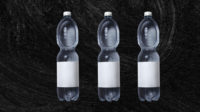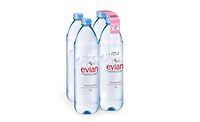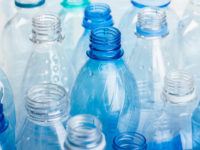In the “Wizard of Oz,” among the many concerns that Dorothy encounters on her quest for home is the musically entertaining “lions and tigers and bears, oh my.” Although not potentially threatening like wild animals, a trio of options often presents itself to beverage manufacturers in the form of packaging: plastic, aluminum and glass, oh my.
As beverage-makers continue to address consumers’ desire for more choices in the beverage aisle, they also are tasked with selecting packages that protect their products, convey their brand messages, and address sustainability and cost at the same time. Although brand owners have a number of other beverage packaging options — such as pouches, cartons, aseptic and bag-in-box — from which to choose, below is an in-depth look at the three primary packaging materials initially named.
Plastic, anyone?
The topic of health and wellness continues to impact the consumer packaged goods (CPG) market, experts note. “The trend toward water and other beverages with real or perceived health benefits continues,” says John Cullen, director of resin sales and marketing for DAK Americas LLC, Charlotte, N.C.
Ron Puvak, director of marketing and new business development for Holland, Ohio-based Plastic Technologies Inc., notes that in addition to flavored bottled waters, the expansion of juice varieties also is fueling the health and wellness trend.
However, this influx of brands and segments within the beverage industry has created a set of challenges. “The proliferation of beverage choices, many of them in PET [packaging], is a positive for the consumer but a challenge for the marketers trying to draw attention to their products and brands,” DAK’s Cullen says.
To help beverages compete on the shelf and resonate with shoppers, Plastic Technologies’ Puvak notes that many leading brands have employed plastic, such as in the cases of Purchase, N.Y.-based PepsiCo Inc.’s Mountain Dew and Tropicana brands. In order to reach its desired target market, the company released a new Mountain Dew bottle last year that featured an embedded logo and styled grip area. In 2012, it unveiled a new Tropicana PET container, which improved functionality with handleware, Puvak explains.
Despite plastic’s design and ergonomics potential, beverage-makers still face the challenge of sustainability or, more specifically, lightweighting. “Lightweighting continues to be a significant trend in PET bottle production as beverage manufacturers seek to reduce their packaging costs and also reduce their environmental footprint,” says Franck Hancard, packaging director of Sidel, Hünenberg, Switzerland. “The drive to take lightweighting even further, however, must not compromise on the performance, the appearance or the feel of the finished bottle.”
Hancard notes that concerns have been raised by consumers about lightweighting because of unintentional spillage in relation to the bottle’s wall structure. To combat this, Sidel focuses not on lightweighting but on “RightWeighting.”
“It is about optimizing in a smart way, taking [material] out of the bottle where you can — typically the base and the neck — while maintaining strength so that the bottle can still perform effectively throughout the supply chain and ultimately provide a great experience for the consumer,” he says.
For example, Sidel’s RightWeight still water bottle concept weighs 7.95 grams with top-load performance of 33 kilograms, Hancard adds.
As beverage manufacturers look to develop packages that adhere to this lightweighting trend, PET resins are a popular choice from which to select, experts note.
“The inherent properties of PET have resulted in the reduction of material usage for same-sized packages without compromising the functionality and the performance of the bottle,” DAK’s Cullen says. “The developments have kept PET very affordable and a good value for beverage companies and consumers.”
PET has shown its penchant as a material of choice for beverages with more than 30 years of successful utilization, Sidel’s Hancard explains. The resin segment can meet a number of demands such as flexibility, transparency and strength, he adds.
“PET is strong, durable, soft, flexible, heat-resistant, shatterproof and corrosion-resistant,” Hancard says. “It also meets the four Rs for sustainability: It can be reduced with lightweighting, reused with refillable solutions, recovered into other objects such as textiles, and, of course, PET is 100 percent recyclable.”
Recyclability is a key component for the plastic bottle industry as well as the respective CPG industries that utilize these packages. “Nothing hurts the perception of plastic more than the image of bottles littering the environment on which we all depend,” DAK’s Cullen says. “Beverage companies along with their suppliers, communities, local governments and non-government entities are all working to improve the recycling rate. In addition, efforts are underway to educate consumers about the value of recycling and of minimizing disposal to landfills.”
Plastic Technologies’ Puvak notes that 30 percent of PET containers are recycled in the United States, but for bottled water, the number over-indexes the overall PET container category with 36 percent, according to the Association of Postconsumer Plastic Recyclers. Sidel’s Hancard notes that, globally, recycling rates for PET in developed countries has improved in the past decade, with Europe nearing a 50 percent recycling rate. However, more needs to be done, he adds.
“Given that recycling of PET uses two-thirds less energy than that used to manufacture virgin PET, there are sound environmental reasons for recycling,” he says.
DAK’s Cullen affirms the recycling and sustainability benefits of PET, saying: “By the nature of its indefinite recyclability, PET can be reused many times with no additional raw material consumption and reduced energy requirements. With the advent of bio-based raw materials like monoethylene glycol made from sugarcane, PET can be produced with reduced consumption of fossil fuels from a renewable resource.”
It seems as though material suppliers and beverage manufacturers are taking notice of this as recycled PET (rPET) gains traction. “Recycled resin is becoming more popular [because of] consumers’ concerns about the environment, but it is also hard to get a regular and consistent source for rPET,” says Collins Speed Pugh, director of marketing with Mountain Valley Spring Co., Hot Springs, Ark., which was recently acquired by Great Range Capital. Pugh notes that the company has started using 50 percent rPET in its PET line.
However, material suppliers are looking to combat the challenges associated with rPET. “Recyclers are making technological inroads by commercializing high-quality and more sophisticated rPET materials,” Plastic Technologies’ Puvak says. He adds that its subsidiary, Phoenix Technologies, developed different grades for specific applications including bottled water and carbonated soft drinks.
In addition to PET and its recycled form, material suppliers are seeing requests for other resins like high-density polyethylene (HDPE) and polyethylene (PE). “Although PET is the leading choice for beverage applications that require high clarity, other resins, such as PE, provide manufacturers with the opportunity to have alternative functionality in non-competing segments,” says Stephanie Kalil, market manager for rigid packaging and durable goods with Dow Performance Packaging, a division of Dow Chemical Co., Midland, Mich.
Kalil notes that Dow developed its Continuum Bimodal Polyethylene, which allows brand owners to lightweight their bottles and closures without sacrificing their functionality. HDPE also offers lightweighting benefits and can be disposed of in local recycling bins, she adds.
‘Metaling’ packaging
Although aluminum containers have a long history within the beverage industry, one category trend is putting a spotlight on this metal packaging.
“The industry is seeing significant growth in the craft beer market, in particular, as more and more small breweries are seeing the benefits of aluminum packaging from a convenience, sustainability and, most importantly, taste perspective,” says Matt Meenan, director of communications for the Aluminum Association, Arlington, Va. “While barely a market a decade ago, today there are nearly 400 craft breweries … packaging beers in cans, according to the industry database craftcans.com.”
Material suppliers also are noticing this trend. Jay Billings, vice president of global innovations for Ball Corp., notes that the Broomfield, Colo.-based company has worked with a number of craft brewery partners to develop aluminum packaging. The company worked with Oskar Blues Brewery to develop the Crowler, a can and growler combination. Billings notes that the 32-ounce can is able to protect the craft beer from light and oxygen in order to preserve its taste.
And as many experts have noted over the years, taste is king. “For brand owners, it is critical to protect the taste of the beverage,” says Neill Mitchell, vice president of marketing and strategic development for Crown Beverage Packaging North America, Philadelphia. “Metal packaging is a powerful barrier against light and oxygen, which conserves the flavor, freshness and carbonation of the product.”
However, when it comes to craft beer, Mitchell notes that more opportunities lie ahead for aluminum packaging. In addition to its preservation qualities, these metal containers also can offer an acceptable portability factor that appeals to the segment’s consumers. “Their robustness also makes them ideally suited for enjoyment during outdoor recreational activities, which is key for many craft brewers,” Mitchell says.
One area that can draw favor from beverage manufacturers in both the alcohol and non-alcohol categories is its environmental benefits. “The aluminum industry works hard to be a good steward of the material,” the Aluminum Association’s Meenan says. “This is a benefit not only from an environmental perspective but also from a business perspective. Producing recycled aluminum saves more than 90 percent of the energy required to make new or primary aluminum.
“In 2012, the aluminum industry’s recycling rate was 67 percent, meaning the industry recycled around 62 billion cans,” he continues. “This recycling saved the equivalent energy of 19 million barrels of oil.”
In addition to aluminum’s recycling rate, material suppliers also are doing their part to reduce material usage while maintaining product integrity. “While aluminum beverage cans are inherently sustainable, we are constantly working on reducing the amount of aluminum we use in each can while not sacrificing Ball’s high quality standards,” Billings says. “This not only helps with reducing the amount of aluminum we use but can help reduce filled goods transport costs.”
Although suppliers in the aluminum industry are proud of the material’s sustainable reputation, they also note that brand owners can benefit from the primary packaging material’s design innovations.
“Brand owners want a package that accurately reflects its brand equity, and for many that means different shapes and more functional packaging,” Billings explains. “Some brands want to project a more sophisticated image and may opt for some of our more sleek and slim cans. Other customers may want to provide reclosability to their on-the-go consumers.” Ball Corp.’s Alumi-Tek bottles can offer the benefits of reclosure coupled with its taste preservation, sustainability and portability characteristics, he adds.
But the innovation doesn’t stop there. In partnership with Molson Coors Canada, Crown developed the Global Vented End beverage can, which features a dual-aperture opening. The two holes allow for a smoother pour, Mitchell says. The company also offers its 360 End package, which allows for the lid to be removed. “The entire lid of the beverage can is removable, turning it into a drinking vessel and ensuring that the full flavor and aroma of the beer hits the drinker’s senses,” Mitchell explains.
Clear as glass
Although craft beer might get the bulk of the attention, beer isn’t the only category crafting up new products.
“One of the biggest trends affecting the beverage industry today is the growing popularity of craft products,” says Beth Peery, regional communications manager for Owens-Illinois (O-I) North America, Perrysburg, Ohio. “From beer to spirits to sodas, consumers are more focused on quality and increasingly seeking smaller producers who deliver artisan products.”
Peery notes that as these products began to gain favor, beverage manufacturers found themselves caught between wanting a quality package and having the capital to develop custom designs and hold large inventories.
“For craft distillers, for example, we put together a suite of timeless, high-quality, cosmetic flint glass bottle designs with a range of customization options to help craft distillers distinguish themselves as they grow their businesses,” she says. “Our Covet Classics product portfolio allows customers to order as little as one pallet at a time and take delivery only when they need it, providing affordable access into the high-end category without sacrificing beauty or speed to market.”
Peery notes that the trend of higher-end products has been complementary to glass because of the primary packaging material’s quality protection characteristics. “Glass bottles naturally protect the taste and integrity of what’s inside,” she says. “For beverage producers who are passionate about what they produce, glass ensures consumers taste it exactly as intended.”
And even though craft beer in cans is gaining traction, glass packaging still remains a major component of the segment. Last June, Verallia North America, Muncie, Ind., announced that it is the exclusive national beer bottle supplier for Lagunitas Brewing Co., as a result of the craft brewery’s
$25 million expansion including its 300,000 square-foot brewhouse set to open in Chicago this May.
O-I also forged craft beer partnerships when it worked with Kona Brewing Co. to redesign its bottle last year. “The bottle features the company’s slogan, ‘Liquid Aloha,’ and an image of the Hawaiian islands on the bottle, which has a new shape and nostalgic feel,” Peery says.
The aesthetics of glass can be appealing for brand owners, experts note. “[Glass] can be shaped, etched, enameled, colored and decorated in an almost infinite number of ways,” says Lynn Bragg, president of the Glass Packaging Institute (GPI), Alexandria, Va. “Ultimately, glass is one of the most customizable packaging options and one of the most appealing across all demographics.”
O-I’s Peery explains that when it comes to packaging design, some segments have style conventions within the marketplace, most notably within the spirits category. “Vodkas, for example, are often packaged in tall, slender bottles for a feminine appeal,” she says. “Whiskeys, which attract more male than female drinkers, are often presented in masculine, broad-shoulder decanter shapes.
“But even as we talk about conventions, we recognize that some craft distillers are breaking them to gain shelf differentiation, and many distillers are packaging a variety of products in one bottle type that represents the brand’s full line,” she continues.
Although aesthetics and taste are key selling points for glass, the industry also boasts the material’s sustainability characteristics. “Sustainability trends constitute one of the main driving forces behind glass packaging,” GPI’s Bragg says. “There is increased awareness on the part of the consumer and manufacturers that sustainable packaging choices are the way forward to protect the environment.”
Bragg adds that the material also can be recycled endlessly in a closed-loop manner. “We have been a strong advocate for improving glass recovery rates nationwide and believe recycling initiatives play a very significant role in the future of glass packaging,” she says.
Material suppliers also are doing their part to help the cause. O-I’s Peery notes that the company began working last fall with eCullet, a recycled glass processor, to open Glass to Glass, a glass processing facility in Portland, Ore.
“Making more of eCullet’s sophisticated sorting technology available to process recycled glass will allow glass that is not being recycled today to be collected and processed so it can be made into new glass containers,” she explains. “Much of the glass currently in the recycling stream, especially glass retrieved through single-stream, curbside recycling, requires sophisticated sorting technologies to produce high-quality recycled glass. ECullet’s patented sorter technology allows this glass to be more effectively sorted and cleaned so that it can be used to make new glass bottles and jars.”









